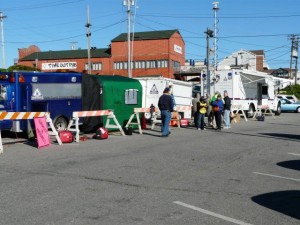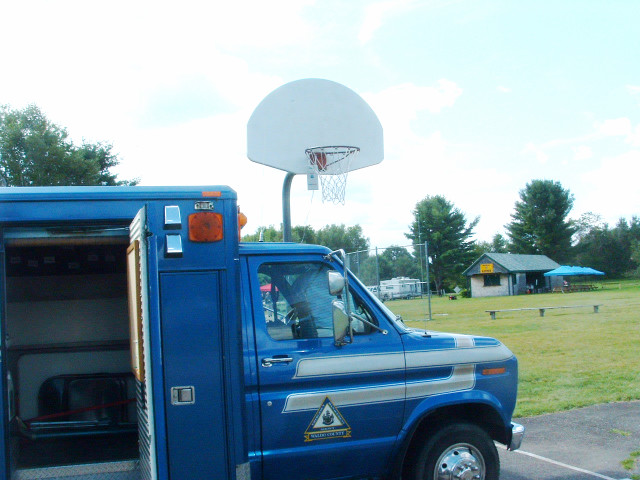A guest post by Steve Hansen (KB1TCE) of Owl’s Head, Maine
 Some Background
Some Background
For a bit of background, I became a ham operator in late 2009. I was part of a small group who saw the value of amateur radio to both personal and community emergency communications during times when the “normal” services (phone, internet, cell) might be interrupted or when the use of these services would be impractical. Besides that, it’s a great hobby with a lot of facets and challenges.
It wasn’t long before I joined the Knox and Waldo County ARES/RACES groups. To explain the acronyms:
- The Amateur Radio Emergency Service, or ARES, is the field emergency service arm of the Amateur Radio Relay League (ARRL). Organizations supported include such groups as the Salvation Army and Red Cross. In addition to emergency operations, ARES operators also provide communications support to community events such as bicycle and canoe races.
- The Radio Amateur Civil Emergency Service, or RACES, is the communications branch of the US Federal Emergency Management System (FEMA). When a governmental entity (here it’s through the county Emergency Management Agencies) requests amateur radio assistance, the response is through RACES.
Somewhere along the line, not long after I got my ham ticket, I heard about Village Telco and the Mesh Potato project. The idea of an infrastructure-independent wifi telephony system sounded like a perfect fit for some aspect of emergency communications. I just wasn’t sure how the project could fit in.
In early 2011 went ahead and ordered 5 Mesh Potatoes to promote some discussion. I promptly semi-bricked one trying to install the SECN software but a friend was able to partially revive it. Around this time I showed the units to the directors at the Knox and Waldo EMAs. Heads nodded affirmatively but the time was not yet ripe and they returned to my home.
2012 Full Scale Exercise
In the fall of 2012 I participated in a full-scale emergency exercise. The scenario was a commuter plane with 18 people on board that made a water landing in Penobscot Bay. Teams were dispatched to a nearby island and the local hospital. Incident management, logistics and operations were conducted from the waterfront park in Rockland. This exercise involved over 20 agencies and upwards of 100 people. Organizations involved included the Knox, Kennebec and Waldo County EMAs, state police, Maine Emergency Management, US Coast Guard, EMTs, etc. A ham was stationed on the island and another at the hospital, plus there were several in a comms trailer at the park. The role of the hams was to relay information from the island (where the “victims” were being triaged) to the base and then to the hospital staff.
It is important to note that exercises of this type work under the premise that normal communications (e.g. cell and internet) and mains power are not available. We work with radios, generators and batteries.
 A portion of the team at the Rockland base is shown in the photo to the right. Base at the Rockland waterfront park, 2012. Units from left to right were for logistics, communications and incident management. There were several other units in the area that are not shown. The Time Out Pub did not directly participate.
A portion of the team at the Rockland base is shown in the photo to the right. Base at the Rockland waterfront park, 2012. Units from left to right were for logistics, communications and incident management. There were several other units in the area that are not shown. The Time Out Pub did not directly participate.
While communications between the various sites was conducted very efficiently, there were three significant gaps:
- The ham operator at the hospital was located in a trailer outside the hospital building. Relaying messages to hospital staff required that he had to leave his post to deliver the message traffic.
- Likewise, the ham operator on the island had to leave his station to get life flight requests and status reports from the triage team.
- Communications between the comms trailer and other units at the base generally required runners to pass hand written messages.
The above issues are usually at least partially addressed by handing out walkie talkies to everyone that may need to communicate between the various units. This has some problems in that the public safety frequency that is used will become jammed if more than one conversation at a time is attempted. Furthermore, many people are just not familiar or comfortable with communicating using a radio. These radios will also interfere with the other nearby radios, even when they operate on different frequencies. Generally, we just go back to passing paper notes.
Enter the Mesh Potatoes
During early 2013 I dusted off the Mesh Potatoes and installed the current SECN firmware (no problems this time!) and brought the units to the Waldo County EMA office in Belfast, Maine for a more formal demo. We set up the MPs within a large conference room and had the network running in minutes. I declared partial success when Dale Rowley, the EMA director, authorized the purchase of the units from me.
At that point, planning was just beginning for another large-scale exercise that would be conducted over 3 days in mid-August. This exercise was named Dirigo Base ’13 Base/Camp and Wildfire Exercise. The goals of this one were to establish a fairly substantial base camp in a rural area and then deploy communications teams to several remote areas to provide communications support to the firefighting teams.
Involved groups included teams from 6 county EMAs, the Maine Air National Guard, the Maine Warden Service and Maine VOAD (a coalition of nonprofit organizations that respond to disasters).
The base of operations was a large park in Monroe, Maine, a small community just west of Bangor. The area over which we were set up was about 125 meters on a side.
Having the Mesh Potatoes in hand, we set up four of them within the base. They were at the entry control point, the incident command vehicle, the comms trailer and the logistics area. The only challenge was mounting them as we really had nothing except for some cord, cable ties and the like. Needless to say they worked and the feedback was quite positive. Best of all, they were easy to use. After all, everyone knows how to use a telephone.
We did not deploy any Mesh Potatoes to the remote communications sites as only single units were sent to those sites during this exercise. Had this been a real event, there would have been multiple teams at the remote locations (as was the case in 2012) and Mesh Potatoes would have been of value there as well.
I believe that the Mesh Potato will become a necessary part of the EmComm tool kit in Maine.
I’ll conclude with some photos of the Mesh Potatoes taken during this exercise.
I would like to thank Dale Rowley, Waldo County EMA Director, Brit Rothrock AB1KI, Mike Coulombe KB1UTD and Mike Courtenay KB1DBL for their assistance and input. Also, a special thanks to Steve Song who quickly responded to every question that I sent him.
~Steve Hansen
